ahmedwaqas92
ODI Debutant
- Joined
- Dec 26, 2013
- Runs
- 10,582
- Post of the Week
- 4
Let me start by dedicating this thread to our very own [MENTION=134608]Hawkeye[/MENTION], one of the fine blokes on PP who has a knack of spotting them early. He has the distinct honor of being one of the first fanb…. Err…..I mean supporters of Sami Aslam  – We all know how well that turned out lol
– We all know how well that turned out lol 
Anyways….. This thread is a continuation, for the list of players that I have embarked upon analyzing based on batting metrics, as these will eventually show us exactly how well suited our batsmen are for the modern game.
Previously, I’ve done similar stats for both Ahmed Shehzad’s (2013-2014) and Azhar Ali (2015 – Present); both these studies revealed telling statistics on why we’ve struggled to embrace the modern game. If you’re not quite aware of what I am referring to then please plough through discussions created by me in the last 2 weeks, I am most certain you wouldn’t be able to miss them.
My third candidate for these numbers, as requested by [MENTION=139982]Sarfarazian92[/MENTION] is Sarfraz Ahmed. This lad debuted in 2007 against India, in an ODI in Jaipur and up until 2013 he almost always played in as a last minute replacement for whenever the 1st choice keeper mucked up horribly. In simpler terms, let’s just say he was the annual vacation, for Pakistani fans, from the Akmal brothers for nearly half a decade.
Honestly speaking, accumulating Sarfraz’s batting numbers and giving proper context to them wasn’t easy; not because he is some unsolvable mathematical equation but because of the fact that all his numbers are scattered through a range of batting positions. To effectively give meaning to such a set of data points that are attained in a different setting against a different opposition in a different era is something that needs extreme detail to attention and a reference point that combines these ranges of values into one meaningful frame.
For this very reason I took two essential steps in determining the subsequent numbers:
(a) Regularity of Appearance (Two sets of Data – Pre 2013 and Post 2013)
(b) Segregation of Data points based on set of Values (Batting Positions)
The numerical analysis done is all but same as to how it was done with Shehzad’s and Azhar’s numbers but the difference lies in the fact that unlike Shehzad and Azhar, Sarfraz has batted in at 7 different positions in the top 8 ever since he debuted – The only position he’s never batted at (in the Top 8) is the #3 position.
In a total of 67 games that he’s represented Pakistan in (up until the West Indies Tour in the U.A.E.) Sarfraz has not batted in 15 of them, the remaining 52 times he has been predominantly been used as a floater, playing to whichever position the team demanded however, it was not until the recent English summer that he was given a stable #5 position.
These 52 innings, as mentioned above are scattered through from the opener’s slot up until as low as #8 and for this very reason I took the following measures in segregating these numbers in three distinct categories.
The preceding filtration gave us a regression model that was based on three individual time series but it helped us bridge the gap in finding context to the scattered numbers of Sarfraz who, before 2013, rarely played in the Pakistan XI.
It also highlighted the flawed strategy that the previous management embarked upon who wanted Sarfraz to played as a lower order hitter / slogger when clearly his natural game was effective strike rotation and being a significant cog in the Pakistani Middle Order for the Modern era.
Alas the subsequent analysis further showcases that even while being played as a floater and sometimes as a make shift opener, Sarfraz Ahmed is probably the only batsmen who is capable to hold his own no matter which position you might play him at.
His batting numbers wipes the floor with players like Shehzad and Azhar when it comes to the opening slot while his middle order scores almost rivals that of Babar Azam, who unanimously, is considered Pakistan’s best limited overs batsmen, so without further a due here are Sarfraz’s ODI inning by inning numbers based on varying batting positions from 2007 up until the last ODI he played in the U.A.E.
Opening Statistics

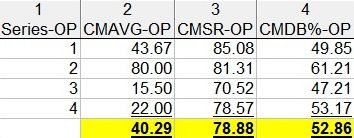
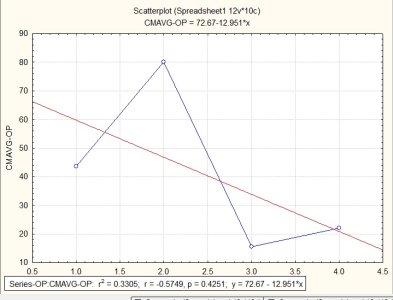
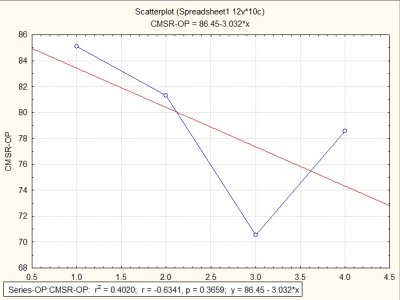
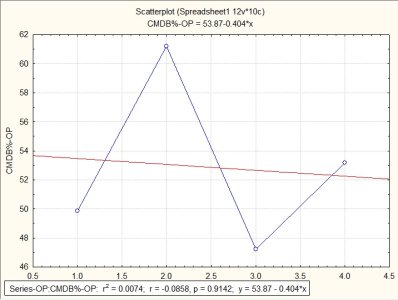
At a tabulated face value, Sarfraz’s numbers are indeed quite impressive. For someone who is considered a makeshift opener he is averaging 40-ish with a cumulative SR of nearly 80. His Dot ball % is a bit high but that should be somewhat acceptable since (a) he isn’t a natural opener and (b) lesser gaps to manipulate during the power play overs.
If we do a vis-à-vis comparison with either Shehzad or Azhar, then Sarfraz would make them seem like the junior cricketers but even with such decent figures there is quite a telling progression to all these.
Looking at the projection graphs from the above one can notice that Sarfraz’s opening trend was on a downward decline for both Cumulative Average and Strike Rate, meaning that even though, similar to Azhar he had a very good start in the top 2, his scores in the latter games were taking a severe hit on his overall numbers and if the same pattern was to be followed then who knows Sarfraz might’ve had similar figures to that of Azhar or Shehzad – These kind of statements however, are pure speculation only but his trend suggests that opening was a indeed makeshift job for him.
What’s encouraging though is that even with a declining average and strike rate, his dot ball percentage had negative progression which clearly meant that even though his prowess for the role was not to be, his natural game awareness and a knack of rotating the strike were the main traits of his game.
Lower Order Statistics
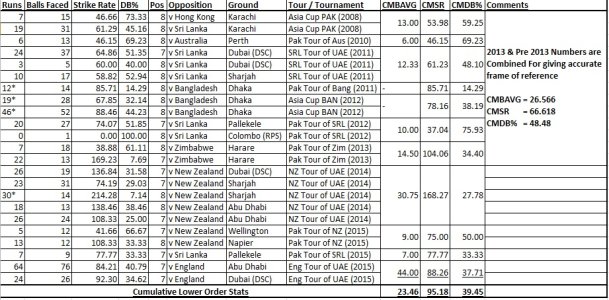

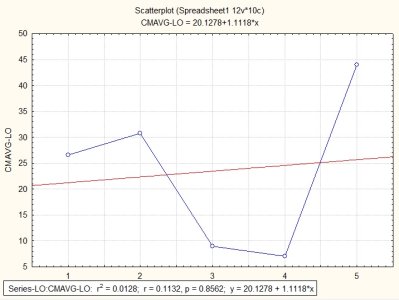
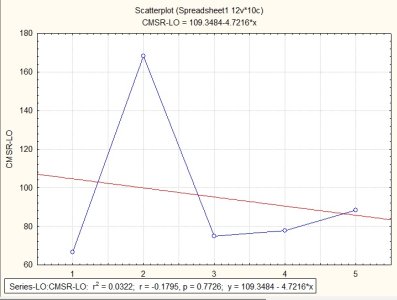
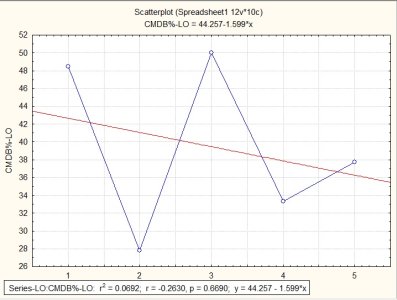
For a period of time in Pakistan Cricket, Sarfraz was expected to succumb to the Umer Akmal syndrome , and in as nearly as 23 innings, ranging from 2007 up until the New Zealand Tour of the U.A.E. in 2014, the lad was considered or more precisely thought off as the natural successor to Razzaq and Afridi.
, and in as nearly as 23 innings, ranging from 2007 up until the New Zealand Tour of the U.A.E. in 2014, the lad was considered or more precisely thought off as the natural successor to Razzaq and Afridi.
For someone who batted so far off from his natural position Sarfraz managed well, to average near 24 runs per innings at almost run a ball. From his progression graphs we can clearly see that his Cumulative SR is relatively stable and in addition he has an inclining cumulative average i.e. a positive trend. It also revealed that his dot ball percentage was decreasing meaning with each passing innings; his strike rotation was improving as well.
These numbers however, don’t necessarily reflect well on his overall game. Even though in context these kind of statistics are decentish, his 23 innings in these testing positions marked his overall batting average to drop to the mid-30s which, in my personal opinion, are not a true reflection of his ability as a reliable middle order batsman.
For this very reason let us now isolate his numbers for the positions of 4, 5 and 6 which will give us a proper verdict on where Sarfraz stands as a batsman.
Middle Order Statistics
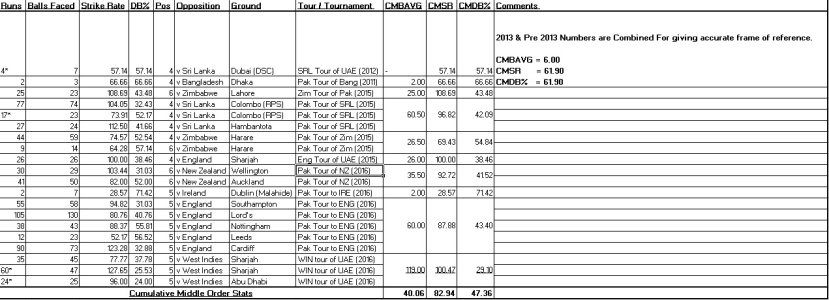
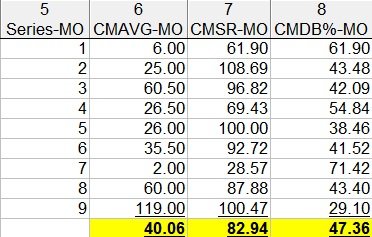
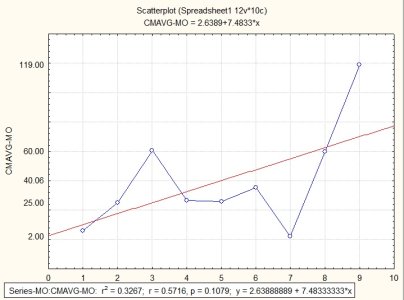
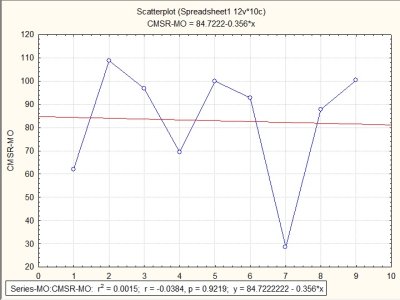
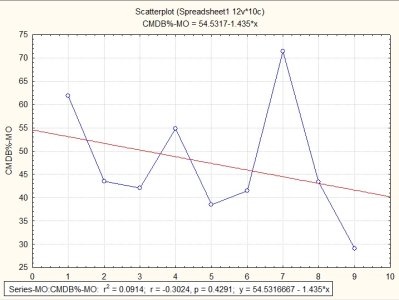
With a cumulative average of and strike rate of 40 and 80+ respectively, it is essentially clear that Sarfraz is the true reflection of a modern middle order batsman. His sample size is also large enough for us to hold these statistics to his name and promptly label him as one of the key elements of the Pakistan LOI batting lineup going forward.
His dot ball percentage, his progression graphs on batting averages & strike rates and other things all indicate him to being one of the best finds in limited overs cricket for Pakistan along with Sharjeel and Babar.
Sarfraz’s true value comes with the fact that he has played in the batting lineup at almost every possible position and in almost every possible scenario a batsman might face during an international career. Plus given how he’s come out of these with such encouraging numbers is a testament to the simple notion that he is a massive element to Pakistan’s good ODI fortune going into the future – something that was indeed dearly missed during the much recent ODI leg of the tour down under.
To along with these traits he has had captaincy experience since a very young age and is the captain of his franchise in PSL as well. All these point to a larger extent for him to eventually be taking over the mantle from Azhar and most probably from Misbah as well in Test while quite frankly with the numbers he’s shown over the years I’d be more than confortable in handing him the latter than someone like an Azhar or an inexperienced lad such as Babar.
Notes:
1) If we exclude Sarfraz’s pre 2013 metrics then his overall average and cumulative SR further improve
2) His cumulative Averages and SR are extremely close to his actual Average and SR which suggest that he has uniformity in his overall numbers, something Azhar and Shehzad well and truly lacked.
3) His progression constant is significantly lower than that of Azhar and Shehzad making him very consistent as a batsman across many different positions.
4) Overall progression can we viewed here:
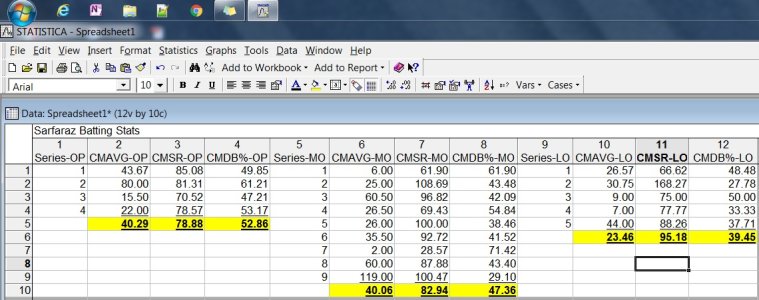
 – We all know how well that turned out lol
– We all know how well that turned out lol 
Anyways….. This thread is a continuation, for the list of players that I have embarked upon analyzing based on batting metrics, as these will eventually show us exactly how well suited our batsmen are for the modern game.
Previously, I’ve done similar stats for both Ahmed Shehzad’s (2013-2014) and Azhar Ali (2015 – Present); both these studies revealed telling statistics on why we’ve struggled to embrace the modern game. If you’re not quite aware of what I am referring to then please plough through discussions created by me in the last 2 weeks, I am most certain you wouldn’t be able to miss them.
My third candidate for these numbers, as requested by [MENTION=139982]Sarfarazian92[/MENTION] is Sarfraz Ahmed. This lad debuted in 2007 against India, in an ODI in Jaipur and up until 2013 he almost always played in as a last minute replacement for whenever the 1st choice keeper mucked up horribly. In simpler terms, let’s just say he was the annual vacation, for Pakistani fans, from the Akmal brothers for nearly half a decade.
Honestly speaking, accumulating Sarfraz’s batting numbers and giving proper context to them wasn’t easy; not because he is some unsolvable mathematical equation but because of the fact that all his numbers are scattered through a range of batting positions. To effectively give meaning to such a set of data points that are attained in a different setting against a different opposition in a different era is something that needs extreme detail to attention and a reference point that combines these ranges of values into one meaningful frame.
For this very reason I took two essential steps in determining the subsequent numbers:
(a) Regularity of Appearance (Two sets of Data – Pre 2013 and Post 2013)
(b) Segregation of Data points based on set of Values (Batting Positions)
The numerical analysis done is all but same as to how it was done with Shehzad’s and Azhar’s numbers but the difference lies in the fact that unlike Shehzad and Azhar, Sarfraz has batted in at 7 different positions in the top 8 ever since he debuted – The only position he’s never batted at (in the Top 8) is the #3 position.
In a total of 67 games that he’s represented Pakistan in (up until the West Indies Tour in the U.A.E.) Sarfraz has not batted in 15 of them, the remaining 52 times he has been predominantly been used as a floater, playing to whichever position the team demanded however, it was not until the recent English summer that he was given a stable #5 position.
These 52 innings, as mentioned above are scattered through from the opener’s slot up until as low as #8 and for this very reason I took the following measures in segregating these numbers in three distinct categories.
Code:
Data Set 1: Position [1, 2] – Opener Category (OP)
Data Set 2: Position [4, 5, 6] – Middle Order (MO)
Data Set 3: Position [x => 7] – Lower Order (LO)
Range : {2007 <= x <= 2013} – Accumulated into a single Data Point, {2013 < x <= Present}The preceding filtration gave us a regression model that was based on three individual time series but it helped us bridge the gap in finding context to the scattered numbers of Sarfraz who, before 2013, rarely played in the Pakistan XI.
It also highlighted the flawed strategy that the previous management embarked upon who wanted Sarfraz to played as a lower order hitter / slogger when clearly his natural game was effective strike rotation and being a significant cog in the Pakistani Middle Order for the Modern era.
Alas the subsequent analysis further showcases that even while being played as a floater and sometimes as a make shift opener, Sarfraz Ahmed is probably the only batsmen who is capable to hold his own no matter which position you might play him at.
His batting numbers wipes the floor with players like Shehzad and Azhar when it comes to the opening slot while his middle order scores almost rivals that of Babar Azam, who unanimously, is considered Pakistan’s best limited overs batsmen, so without further a due here are Sarfraz’s ODI inning by inning numbers based on varying batting positions from 2007 up until the last ODI he played in the U.A.E.
Code:
Tabulation Key:
CMBAVG – Cumulative Batting Average: the aggregate mean for batting averages that a player attains per series for a given range of data
CMSR – Cumulative Strike Rate: the aggregate mean for Strike Rates that a player attains per series for a given range of data.
* I remember that there was some confusion in the previous thread(s) on what exactly the CMSR represented. Well, to put it simply it is the mean (average) taken for strike rates that a batsman manages to attain per series. This means that if his SRs for a set of 5 series are 50, 75, 60, 100 and 80 respectively then his CMSR would be 73.00.
This CMSR value would be a notch below the actual SR for a given individual but by taking an average for all the accumulated SRs for a player we duly eliminate any irregularity and reduce scalability so that a true reflection would show us the SR for an individual batsman that can be attained irrespective of match situation.
I’ve had also used this same metric in the analysis done for Shehzad and Azhar and eventually I will use this to create an impact index for all our batsmen once we are done with the individual Inning by Inning Batting Analysis for the Top 7.
CMDB% - Cumulative Dot Ball %: the aggregate mean for the accumulated dot ball percentages that a player attains per series (self-explanatory).Opening Statistics





At a tabulated face value, Sarfraz’s numbers are indeed quite impressive. For someone who is considered a makeshift opener he is averaging 40-ish with a cumulative SR of nearly 80. His Dot ball % is a bit high but that should be somewhat acceptable since (a) he isn’t a natural opener and (b) lesser gaps to manipulate during the power play overs.
If we do a vis-à-vis comparison with either Shehzad or Azhar, then Sarfraz would make them seem like the junior cricketers but even with such decent figures there is quite a telling progression to all these.
Looking at the projection graphs from the above one can notice that Sarfraz’s opening trend was on a downward decline for both Cumulative Average and Strike Rate, meaning that even though, similar to Azhar he had a very good start in the top 2, his scores in the latter games were taking a severe hit on his overall numbers and if the same pattern was to be followed then who knows Sarfraz might’ve had similar figures to that of Azhar or Shehzad – These kind of statements however, are pure speculation only but his trend suggests that opening was a indeed makeshift job for him.
What’s encouraging though is that even with a declining average and strike rate, his dot ball percentage had negative progression which clearly meant that even though his prowess for the role was not to be, his natural game awareness and a knack of rotating the strike were the main traits of his game.
Lower Order Statistics





For a period of time in Pakistan Cricket, Sarfraz was expected to succumb to the Umer Akmal syndrome
 , and in as nearly as 23 innings, ranging from 2007 up until the New Zealand Tour of the U.A.E. in 2014, the lad was considered or more precisely thought off as the natural successor to Razzaq and Afridi.
, and in as nearly as 23 innings, ranging from 2007 up until the New Zealand Tour of the U.A.E. in 2014, the lad was considered or more precisely thought off as the natural successor to Razzaq and Afridi. For someone who batted so far off from his natural position Sarfraz managed well, to average near 24 runs per innings at almost run a ball. From his progression graphs we can clearly see that his Cumulative SR is relatively stable and in addition he has an inclining cumulative average i.e. a positive trend. It also revealed that his dot ball percentage was decreasing meaning with each passing innings; his strike rotation was improving as well.
These numbers however, don’t necessarily reflect well on his overall game. Even though in context these kind of statistics are decentish, his 23 innings in these testing positions marked his overall batting average to drop to the mid-30s which, in my personal opinion, are not a true reflection of his ability as a reliable middle order batsman.
For this very reason let us now isolate his numbers for the positions of 4, 5 and 6 which will give us a proper verdict on where Sarfraz stands as a batsman.
Middle Order Statistics





With a cumulative average of and strike rate of 40 and 80+ respectively, it is essentially clear that Sarfraz is the true reflection of a modern middle order batsman. His sample size is also large enough for us to hold these statistics to his name and promptly label him as one of the key elements of the Pakistan LOI batting lineup going forward.
His dot ball percentage, his progression graphs on batting averages & strike rates and other things all indicate him to being one of the best finds in limited overs cricket for Pakistan along with Sharjeel and Babar.
Sarfraz’s true value comes with the fact that he has played in the batting lineup at almost every possible position and in almost every possible scenario a batsman might face during an international career. Plus given how he’s come out of these with such encouraging numbers is a testament to the simple notion that he is a massive element to Pakistan’s good ODI fortune going into the future – something that was indeed dearly missed during the much recent ODI leg of the tour down under.
To along with these traits he has had captaincy experience since a very young age and is the captain of his franchise in PSL as well. All these point to a larger extent for him to eventually be taking over the mantle from Azhar and most probably from Misbah as well in Test while quite frankly with the numbers he’s shown over the years I’d be more than confortable in handing him the latter than someone like an Azhar or an inexperienced lad such as Babar.
Notes:
1) If we exclude Sarfraz’s pre 2013 metrics then his overall average and cumulative SR further improve
2) His cumulative Averages and SR are extremely close to his actual Average and SR which suggest that he has uniformity in his overall numbers, something Azhar and Shehzad well and truly lacked.
3) His progression constant is significantly lower than that of Azhar and Shehzad making him very consistent as a batsman across many different positions.
4) Overall progression can we viewed here:












 to OP for the effort.
to OP for the effort.

